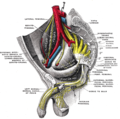Top Qs
Timeline
Chat
Perspective
Sympathetic trunk
Bundle of nerve fibers From Wikipedia, the free encyclopedia
Remove ads
The sympathetic trunk (sympathetic chain, gangliated cord) is a paired bundle of nerve fibers that run from the base of the skull to the coccyx. It is a major component of the sympathetic nervous system.
Remove ads
Structure
The sympathetic trunk lies just lateral to the vertebral bodies for the entire length of the vertebral column. It interacts with the anterior rami of spinal nerves by way of rami communicantes. The sympathetic trunk permits preganglionic fibers of the sympathetic nervous system to ascend to spinal levels superior to T1 and descend to spinal levels inferior to L2/3.[1][2][3][4][5][6][7]
The superior end of it is continued upward through the carotid canal into the skull, and forms a plexus on the internal carotid artery; the inferior part travels in front of the coccyx, where it converges with the other trunk at a structure known as the ganglion impar.
Along the length of the sympathetic trunk are sympathetic ganglia known as paravertebral ganglia.
- The sympathetic trunk (yellow) can be seen just lateral to the vertebral column.
Relations
In the cervical region, the sympathetic trunk is situated upon the prevertebral fascia posterior to the carotid sheath.[8]: 600
Remove ads
Function
Summarize
Perspective
The sympathetic trunk is a fundamental part of the sympathetic nervous system, and part of the autonomic nervous system. It allows nerve fibres to travel to spinal nerves that are superior and inferior to the one in which they originated. Also, a number of nerves, such as most of the splanchnic nerves, arise directly from the trunks.
Remove ads
Additional images
- The formation of the spinal nerve from the dorsal and ventral roots.
- Dissection of side wall of pelvis showing sacral and pudendal plexuses.
- Sacral plexus of the right side.
- Diagram of efferent sympathetic nervous system.
- Sympathetic connections of the ciliary and superior cervical ganglia.
- Sacral sympathetic
See also
References
External links
Wikiwand - on
Seamless Wikipedia browsing. On steroids.
Remove ads









